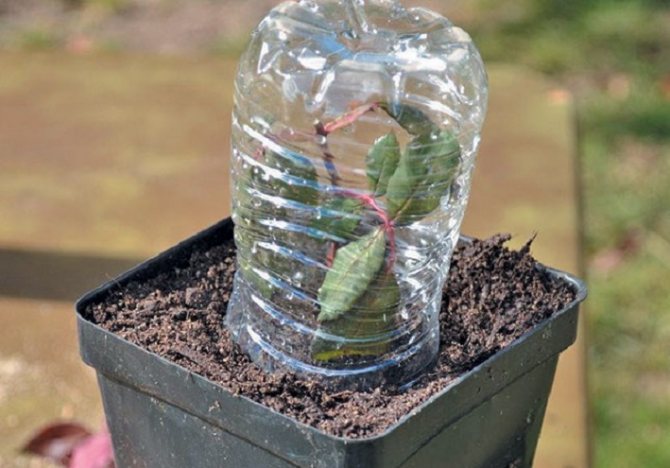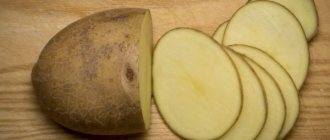
Sometimes it happens that the donated roses in a vase stand for so long and are so strong in themselves that they begin to sprout.
Although the roots that have appeared are still weak, many flower growers have a question: “What to do? Is it possible to grow a whole bush from a sprouted rose? "
This article will try to answer all these questions. We will talk about why roses sprout, whether it is possible to specifically force them to take root in a vase, and also what to do in order to plant young shoots on your own.
What kind of flowers can sprout?
Roses that have been in the store for a long time will never germinate: there are often drugs added to the water that extend the life cycle of the plant, but negatively affect root formation. As a rule, in such cases, the bottom of the shoot turns black, or the entire stem wrinkles slightly. Such flowers will never take root. Flowers purchased on March 8 are more likely to take root: they do not linger on the store counter, and spring only promotes active vegetation, however, like summer.
You should also immediately stipulate: roots can appear on the stem of almost any rose, but this is not a guarantee that it will be possible to get a new plant, especially when it comes to Dutch hybrids. Most of the varieties imported from abroad are treated with special preparations that slow down the process of wilting of the plant, but at the same time reduce its ability to root. Therefore, roses grown locally are most likely to root (and later take root) in a vase.
The resulting rose will also be guaranteed frost resistance problems. In addition, cut plants have already spent a lot of energy on flowering, so often those who seem to be starting to release rose roots simply die when planted in the ground.
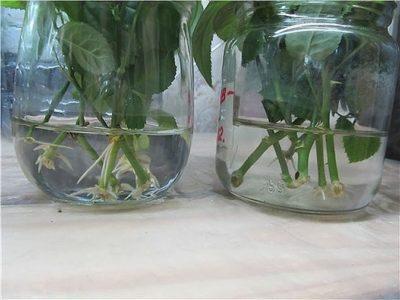

It is believed that the roots are more likely to appear on those stems that are placed in a vase of opaque materials (better than dark glass).- At the same time, the water in the container does not change, but is only topped up as it evaporates. Previously, you can throw an activated carbon tablet into it.
- The water should be boiled or melted, since pathogenic microbes are present in large doses in raw water.
- The level of water in the vase is also important: if there is too much of it, the stem will most likely rot, since there will not be enough oxygen in the container (roots form at the border of water and air).
- There must be leaves on the stem of a rose: according to experienced flower growers, it is the leaves that produce a substance similar to a biostimulator of root formation, for example, heteroauxin. However, the leaves should not be immersed in water, otherwise they can provoke putrefactive processes.
- Naturally, the room where the bouquet is located should be light and warm enough (+ 20C - + 24C).
How do you know that they have taken root?
You can take cuttings from a rose only when the flower begins to shed its petals. After the flowers stand in the water, a process with young leaves may appear on the stems. This is the element that can be used to further preserve the plant. If there are several such processes, then you can try all of them.
It is not a fact that the flowers will survive, because often shop roses are infected with various pests, they are sprayed with harmful substances that artificially prolong the preservation of the bouquet, but reduce the survival rate of the flower to zero. Therefore, it is always advisable to rinse and trim the stems of the plant before placing it in the vase.
How to plant and grow?
What if the flower has sprouted?
- Prepare tools. To plant a sprouted rose in the ground, you will need:
- a sharp garden knife treated with an antiseptic;
- flower pot;
- substrate;
- drainage (should occupy ¼ part of the pot);
- glass jar (cut bottle or plastic bag).
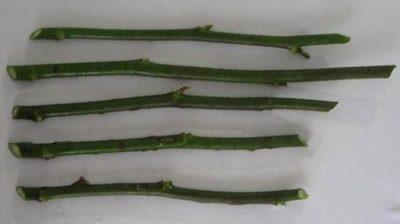

Make a stalk out of a sprouted rose. How can you make cuttings for planting?- The first step is to remove the bud of the plant (this is done long before the planting process, as soon as the flower wilted).
- Then, from the middle part of the shoot, cut a stalk with 3 - 5 intact buds and a total length of 15 - 20 cm.
- The lower part of the cutting remains with sprouted roots, but the upper part is cut at a right angle at a level of 2 - 3 cm above the upper bud.
- Process the cutting. All leaves should be removed from the cutting, leaving only a couple of the upper ones, but they must also be shortened by ½. To prevent infection of planting material, it should be immersed in a pink solution of potassium permanganate for a day.
- Place in a container. The container is filled first with drainage (expanded clay, broken brick, pebbles, etc.), then with a substrate. A recess is made in the ground, into which you can easily place a stalk 2/3 of its length and gently straighten only the roots that have appeared. The shank is deepened at an angle of 45 degrees.
- Rooting. It may take different times to form a full-fledged root system. If the soil is warmed up, then in a month, the other roots will get stronger and develop. At this point, it is quite possible that an shoot will begin to grow from the bud.
- Provide care for a young plant. Immediately after planting the cutting, the soil is watered abundantly, and the pot is exposed in a well-lit place, but without direct sunlight. The recommended temperature for the "engraftment" of roses should be + 25C.
Ways to take a shoot from a rose
Before figuring out how to take a shoot from a rose, it is worth studying the rules for choosing it, according to which it will be more suitable for growing from scratch. Requirements:
- the flower must be fresh;
- for grafting, it is best to use the middle part of the stem;
- the rose must be of domestic production. Foreign flowers are treated with various chemicals. Because of this, the rose may not sprout;
- there should be 2-3 buds on one cutting;
- the stem of the rose should be thick, juicy and green;
- the buds should be fully ripe and not dark.
The shoot of a rose
A rose is not suitable for growing if:
- the flower has been cut for a long time and stands in a vase for a long time, since there are most likely harmful microorganisms in its stem;
- the stem of the flower is too thin or woody with a thick core;
- the stem turned dark in the water;
- cracks appeared on the stem;
- there is no skin on the stem in some places.
Important! You can't keep a rose for a long time in order to root it. Immediately after the flower is purchased, it must be planted.
Also, the stalk should be properly prepared:
- cut the cuttings from the stem, leave a length of 20-30 cm. Pruning is done with a sharp knife or pruner to prevent injury to the stem. Also, the tool must be pre-disinfected to exclude infection;
- remove the bottom leaves, thorns, buds, bad buds. The upper leaves are shortened by 1/3;
- the bottom is cut at a 45 degree angle and the top is straight. Everything is lubricated with wax. Slices must be done so that from vital buds to a cut is 1 cm;
- clean settled water is poured into the container. A root growth stimulator (Kornevin, Epin, Charkor) is diluted in water.The drugs are used in accordance with the instructions on the package. The cuttings are immersed in water for 1/3 for 6 hours. You can also make a homemade solution from a glass of water, twenty drops of aloe juice, or a teaspoon of honey. In this solution, the stems are soaked for a day.
Increased chances of survival
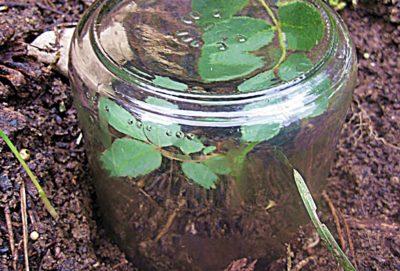

The rose takes root in conditions of high humidity, therefore, it is advisable to cover everything on top with a glass jar or plastic bag to increase the chances of survival of the cutting.
Experienced flower growers recommend not to remove the jar until it is clear that the rose has begun to grow (it releases new shoots and leaves).
And only then the "greenhouse" can be opened for a short while, gradually accustoming the young plant to the dry air of the environment that is unusual for it. The total duration of time from the moment the cuttings are covered with a jar and until the moment they are removed is about six months.
Mistake 5: eating the wrong way
Many inexperienced gardeners try to feed their favorites as best they can during flowering ... and make a huge mistake.
Why is it wrong?
It is not always good to feed the plant. Such a seemingly good deed can sometimes lead to the loss of flowers, and even to the death of a rose bush.
It is important to understand when and what fertilizers does a rose need
, and what will be harmful for her:
- It is important for a plant to receive a complete complex fertilizer, including nitrogen, potassium and phosphorus in equal proportions, in early spring, and during flowering it will only bring harm.
- Nitrogen is needed in the spring and in the first half of summer for the active growth of shoots and leaves, and in the fall it will become an enemy for the plant, because the new shoots, the growth of which it will provoke, will not have time to get stronger and will almost certainly freeze out in winter.
- Phosphorus and potassium contribute to abundant flowering, so they will be useful and appropriate during the budding period.
- The last feeding is carried out in mid-September using a phosphorus-potassium mixture, and later fertilization will not bring any benefit.
- Overripe and semi-rotted manure is an excellent organic fertilizer, and fresh manure will cause burns on young roots.
- During the flowering period, it is advisable to suspend any feeding altogether.
In the next video, Irina Makhrova will show us how rose bushes are fed in practice:
If you want your roses to be healthy and happy with abundant flowering, feed them correctly.
Problems and difficulties
Rose roots grown in water have a completely different structure than those that emerged as a result of the rooting of a flower in the ground. Roots from water are thinner, weaker, translucent, fragile and very sensitive to rot... They can be easily injured or even broken off when transplanted into the substrate. Therefore, when planting, you must be as careful as possible, otherwise the plant will have to go through the rooting process again, and this, as a rule, ends in failure.
The water contains an insufficient amount of oxygen, and therefore the following phenomenon can often be observed: the rose "grew" strong enough roots in a vase, and when it was planted in the soil, it died, the adaptation process failed. This is the main disadvantage of rose propagation by rooting in water.
A rose sprouted in a vase can be planted both in a pot and in open ground. But you must remember that this breeding method is very unreliable. Therefore, do not despair if the attempt to grow a new bush is unsuccessful. Rose is a very moody flower. You should be patient and try your luck next time.
Mistake 3: incorrect summer pruning
Pruning roses in summer is a very important care element. Therefore, it is worth paying attention to the two most common mistakes in this area.
Withered flowers remain on the branches
Many gardeners never remove wilted flowers from a bush.The petals fall off, and the fruits seem to remain on the branches that do not interfere with anyone. But only "kind of like" - in fact, this is wrong. Such carelessness in care can call into question all subsequent flowering of the bush this year.
Photo from the gardener's magazine site
Why is it wrong?
Because, as it should be in nature, the plant will consider its mission of flowering completed and will begin to "work" on the formation of fruits and preparation for winter. But we need the rose to bloom! Therefore, it is necessary to cut the flowers without waiting for them to wilt, which stimulates the bush to further flower formation.
And how to perform such a summer pruning of roses is shown in this video:
The work will not take long, and the benefits are enormous.
Shoots without flowers are ignored
Unfortunately, we practically do not pay attention to blind shoots - those that do not bear flowers, believing that "the bush itself knows where to give flowers, and where not."
Why is it wrong?
By ignoring these shoots, we ourselves are depriving ourselves of many new flowers. But it is enough to activate such shoots by pruning, and they will turn into blooming!
The following video explains and shows in detail how to correctly conduct a stimulating blind shoot pruning:
It is worth cutting off blind shoots correctly, and the appearance of new flowers will not take long.
Useful video
We suggest watching a video on how to root a rose from a bouquet that has already sprouted in a vase:
If you find an error, please select a piece of text and press Ctrl + Enter.
· Hemp above the upper and lower bud of the finished cut of the cut should be about 5-7 mm;
· The upper compound leaf is shortened by 1 / 2-1 / 3, and the covering leaf of the lower bud is removed completely, leaving only the petiole (1.5 cm);
Only a part of the cutting with the lower bud is buried in the upper sandy layer at an oblique distance of 1.5-2 cm;
· Over the cuttings you need to install a small frame and cover it on top with plastic wrap;
· The height of the frame should be such that the film does not sag and does not touch the cuttings;
· Cuttings are regularly sprayed.
In an amateur setting, it is difficult to create optimal rooting conditions conducive to root formation. To do this, the temperature of the substrate in the box should be 2-3 C higher than the air temperature.
At normal room temperature, rooting takes at least 1 month. Try to resist the temptation and do not dig in early rooting cuttings to see if roots have appeared there.
How the cuttings take root can be judged by the speed of awakening of the upper axillary bud. The relationship is the opposite: if in the first weeks the bud quickly awakens and shoots, this means that the process of root formation is slowed down or stopped so much that rooting may not take place. On the contrary, if the upper kidney does not awaken for a long time, this means that intensive root formation is taking place.
Cuttings are planted from under the frames in the formation phase of at least 5 roots about 4-6 cm long. Roses grow better in plastic and polyethylene vessels with drainage and a hole at the bottom. Pottery for roses is less suitable.
In the conditions of a long dark Siberian winter, roses in a room without powerful additional lighting grow poorly, get sick, and bloom poorly. If you really love roses, grow them outdoors in the garden!
Rose seedlings grown from rooted cuttings should spend the first winter indoors (in a room or cellar), since in a short summer period they do not have time to develop enough and, as a rule, die. This is the main difference between self-rooted roses and grafted ones - slow development in the first year of life.
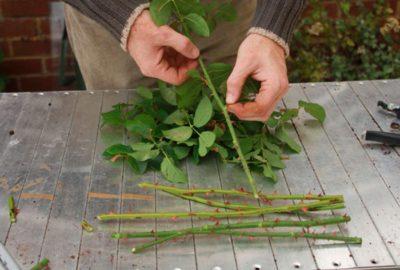

Many elite varieties of roses are difficult to get into your own collection in the form of an adult plant or to get seeds.To obtain a healthy and beautiful specimen, you can resort to propagation of roses by cuttings. The option of growing seedlings from cuttings is versatile and easy to perform, as well as its availability. You will read about how to cut a cutting for planting, how to properly propagate a plant in spring or autumn, how to understand that the cuttings are rooted and need to be planted, and also why cuttings germinated in water sometimes turn black, you will read in this article.
Florist tips
- If you add river sand or crushed shells to the pot where the cutting will be planted, this will help to avoid stagnation of moisture, and a sufficient amount of oxygen will also flow to the roots.
- If a decision is made to root roses from a bouquet, it is necessary to carry out preparatory procedures. Change the water in the vase every day. At night, the flowers sink their heads down into a bowl of water.
- A flower that has taken root in the winter must be brought indoors or moved to a greenhouse. Under natural environmental conditions, the bush is left only for the second year of life, while it is well insulated.
- Do not apply too much fertilizer. The very first application of top dressing is carried out with minerals when the plant reaches a length of a quarter of a meter.
- If buds appear on newly rooted seedlings, they should be removed so that the plant does not waste energy on flowering.
- In practice, the most effective cultivation of roses by cuttings is possible in those flowers, the buds of which are pink or red. More problems arise with yellow roses. The most problematic are roses with white flowers.
- When preparing the cutting, do not remove all the leaves on it, as this can contribute to poor juice circulation.
- Under any environmental conditions, after planting the cuttings in the ground, a shelter is made from cans or plastic bottles on top. This creates a greenhouse effect and protects the seedling from adverse environmental conditions. Jars are opened only after the cuttings have taken root.
Having analyzed and studied the methods of cutting roses, you can be sure that it is quite possible to grow a rose at home. The most important thing is the correct execution of all stages of work.
Rose is an object of adoration and admiration. Shakespeare mentioned the flower in his poems dozens of times, the Confucius library has collected 600 volumes about it, and the United States, England and Iran called the rose the national flower.
In Russia, roses are perhaps the most popular way to show attention.
What to do if the presented bouquet of roses unexpectedly sprouts? By Rambler / Family.
If you do not want to part with flowers, try to transplant the flowers into the soil.
Keep in mind: summer cuttings take root better, it will be more difficult for spring shoots to take root, winter ones will survive only in the hands of a real fairy.
The process will require:
- sharp secateurs or knife;
- a flower pot with a universal soil;
Preparation:
To begin with, choose a suitable stem of medium thickness. We remove the lower leaves, since they will rot when touching the soil, along the cutting - cut it in half, so the circulation of juice will remain in the cutting.
Cut the stem horizontally at the top and at an angle at the bottom: this will increase the absorbent surface. Cut off the stem below the fresh shoot, retreating 2 centimeters.
We go for a trick and process the cuttings with a growth hormone: Kornevin, Epin, Zircon, natural aloe juice will help you. Leave the sprouts in this solution for 8-12 hours.
Soil preparation:
We take land, peat, sand in a ratio of 2: 1: 1. So gradually the roots will receive nourishment from the peat, and the sand will help to avoid excessive wetting.
Transfer:
We plant the cuttings to a depth of 2-3 cm. Pour with settled water at room temperature and cover with a jar or a plastic greenhouse.
For the first two weeks, the flower will require close attention: we spray it with water up to seven times a day, gradually reduce the number of waterings to two.
In matters of watering, moderation is important: roses equally do not tolerate stagnant water and dry soil. So water as needed.
Most flowers in pots feel more comfortable in a sunny and ventilated place - the leaves dry out, and the likelihood of contracting fungal diseases decreases. Important: Avoid places where hot air stagnates.
After the roots appear on your rose, young shoots and leaves will break through. Do not remove the jar immediately, gradually accustom the shoots to dry air. Gradually increase the airing time. Continue sprinkling water on the cuttings with shoots every day after removing the greenhouse. If buds appear, remove, since the main task is the development of the root system.
Roses have a deep root system, so they need a pot of at least 60 cm in depth and in diameter. In such a pot, roses can not be transplanted for about five years.
After 4 weeks, it will become clear if the roses are rooted. To do this, pull the stem up from the ground - if you feel resistance, the goal is achieved.
If you want to plant a flower in the ground, wait until early spring or late autumn. Remember: problems can arise with the wintering of roses, therefore, for roses, the autumn transplantation time is August and September.
The rose is a moody flower, but the efforts made will pay off with interest in its beauty and the beauty of your home!
Cutting - what is it?
A cut is meant a part separated from the plant and used for further germination. As a rule, a stalk is a stem, less often a branch or leaf of a flower, with which you can breed a new bush. Young freshly cut shoots are most suitable for vegetative propagation. Cutting is the process of rooting a segment of a plant, with the further formation of new roots and buds. Even from a branch of short length, subject to all the necessary conditions, a new luxurious plant can grow.
Preparing rose cuttings
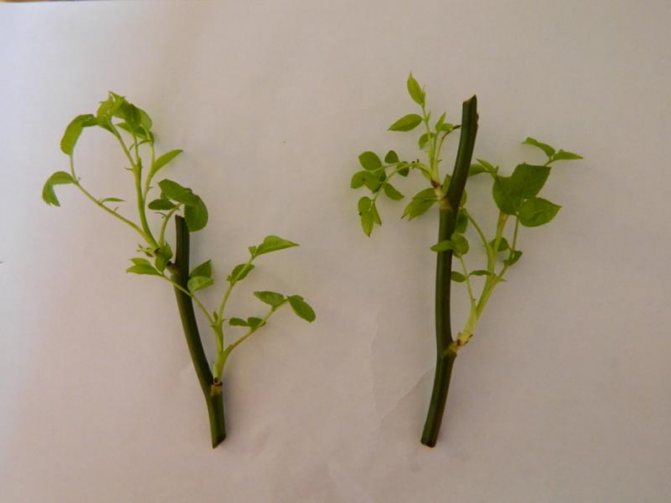

There are nuances that you need to pay attention to if you want the rose to take root. When choosing stems on which new shoots have sprouted, preference is given to large, strong, without damage. It is taken into account that imported flowers are treated with chemicals that extend shelf life. This worsens the chances of root formation. Your best bet is to try and plant a Russian rose.
A sharp knife or pruner is used to cut the cuttings. The preparation process is always the same, no matter what material is used - a purchased bouquet from the salon or a branch plucked from a bush in the garden.
- The location of the cuts on the selected stem is determined - on the cuttings, in addition to the hatching shoot, there should be two more buds. The length varies from 5 to 15 cm.
- The upper cut is made horizontally, at a distance of at least 2 cm from the upper kidney.
- Under the lower bud, the stem is cut at an angle of 45 °, creating a vast area for the absorption of moisture and nutrients.
- The leaves are cut off completely from the bottom, leaving a small stump.
- The upper leaves are cut in half each so that the sap flow does not stop, but the need for nutrition is reduced.
- The cuttings are placed in water in which a growth stimulant is previously dissolved - Kornevin, Rostok, Heteroauxin, aloe juice or honey.
Where to buy a seedling?
Rooting a rose cut is a fun process, but more for fun and experimentation. Currently, flower shops, private and suburban nurseries, botanical gardens offer a lot of varieties of roses: tea, park, Dutch, bush and peony roses. Specialized companies are ready to shower flower growers with various hybrids, of which there are more and more every year.
Buying an already adult flowering plant is an unjustified risk. and a waste of money.The grown rose, most likely, will not take root in a new place, getting used to the greenhouse conditions. A safe bet is to buy an already rooted rose cut in a container. A large seedling with its own root system and green mass will cost a resident of Moscow 550 - 700 rubles, depending on the variety. Nurseries of St. Petersburg offer local residents seedlings in the price range from 270 to 380 rubles.
How to care for the planted processes


Caring for rose branches does not require any special measures. It is necessary to periodically loosen the ground around the plant. This will provide air access to its underground part. Watering in hot and dry weather should be frequent, but do not fill, as the roots can rot
Top dressing can be done with organic fertilizers, such as rotted manure or compost. In addition to feeding the plant, they will keep moisture in the ground from evaporation.
How to save shoots?
Before planting, cuttings need proper maintenance. For successful rooting, the correct plant segments must be selected. Cut shoots from rose bushes are suitable as material. It is worth separating the cuttings after the formation of buds on the bush - this method is called green cuttings. At this point, the plant has accumulated a sufficient supply of micronutrients to survive pruning.
There are several proven ways to save cuttings.:
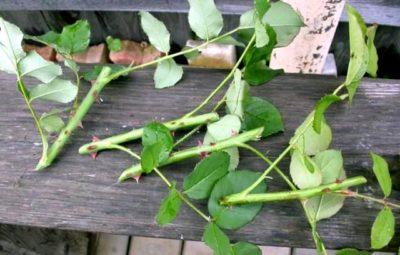

The freshness and vitality of the cuttings can be provided by sphagnum moss, which helps to maintain optimal moisture. The shoots wrapped in moss should be stored in the refrigerator at a temperature not exceeding +5 degrees.- If you have a summer cottage, you can dig a hole 20 centimeters deep. The bottom should be laid with soft cloth and the cuttings should be buried until spring.
- If you have a limited supply of materials at hand, you can arrange for the cuttings of roses to have a simple but reliable wintering on the bottom shelf of the refrigerator. The shoots should be wrapped in a slightly damp cloth and placed in a cool, dark place until spring.
- If rooting is delayed for several days, the cuttings can be placed in warm water with a few drops of Epin.
When using natural moss to preserve cuttings, it is necessary to carry out preliminary disinfection. For these purposes, the drug Fitosporin-M is perfect.
How to "force" them to sprout young shoots?
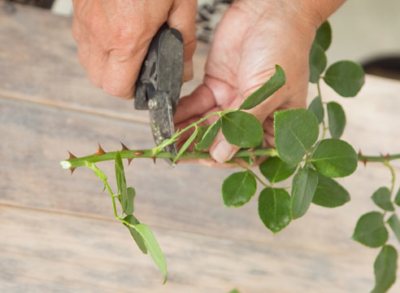

Consider how to grow a sprout. To do this, let's analyze the procedure:
- You need to cut off the stem by five centimeters.
- Wash off excess chemicals.
- Put water in clean room temperature,
- Expose to light. It is best to use special indoor plant lamps.
- Next, check if there are any pests on the rose. Most often it is a spider mite. Take a close look at the fallen leaves: if the reverse side is covered with a dusty layer, and there are cobwebs between the branches of the rose, then an insecticide must be urgently used.
Then, when the leaves begin to fall off, check for small shoots on the stems. It is them that you will use for planting.
What time of year should you choose to plant a plant?
In the presence of bottom heating and additional lighting, you can root cuttings of roses at any time of the year. Fluorescent lamps or phytolamps allow you to achieve results when multiplying bush flowers even in autumn and winter. Keep in mind, however, that the best breeding time is late spring and early summer. Nature wakes up, daylight hours increase - seedlings will certainly respond to favorable natural growing conditions.
Best months to breed: May-June, and green cuttings of roses in the open field in the garden should also be rooted in late spring, early summer. This time of the year has an optimal temperature, which allows the soil to warm up enough and prevent decay of the seedlings. High summer, on the other hand, will have a bad effect on the rooting of roses.For this season, it is necessary to create cool conditions for the cuttings.
Growing a rose in water
Place the cuttings in a jar of water and place in a quiet, dark place.
Create a greenhouse effect if desired, but this is not necessary.
Change the water every two days. When the first hairs of the roots appear at the end of the stem, you can transplant the rose into the ground.


Any dacha, garden plot and apartment are transformed when beautiful plants and bright flowers appear on them. And unusual varieties will surprise not only guests, but also experienced flower growers.
To plant your favorite flowers, there is no need to buy expensive planting material in the store, there is a more budgetary way.
Is it possible to germinate a rose from a bouquet, what conditions are necessary for this and what to do with the rooted plant further? All these issues are discussed in detail in the article.
How to root it correctly to take root?
Rooting roses in soil is the most effective and common way of root formation. Such a procedure does not require large material costs and unusual materials from the grower. It is enough to devote a little time to creating a greenhouse for cuttings. The gardener does not have to constantly monitor the temperature and the availability of water, the seedlings do not risk rotting, and immediately adapt to suitable conditions. Also, fertilizers can be initially applied to the soil, which will speed up the process.
- To carry out the initial stage of rooting a rose cuttings, a florist will need a set of the necessary equipment and planting materials:
- Plastic deep container.
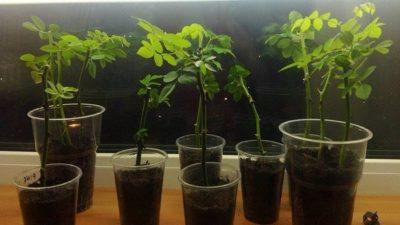

Pallet (if rooting occurs at home).- Priming.
- Expanded clay.
- Perlite.
- Vermiculite.
- Root preparation.
- Cellophane, cling film, or cut plastic bottle.
- The soil for rooting cuttings must be aerobic and rich in nutrients. You can purchase ready-made soil, enriched with humos, horse manure or humus, or take garden land from the site. In any case, it is advisable to mix the finished substrate with perlite and vermiculite to increase the looseness and air permeability of the soil. The total ratio of baking powder should not exceed 40 percent of the total land mass.
What you need to transplant a rose
To get a beautiful bush from a donated flower, it must first be rooted, and then planted in the ground. You do not need any special devices for this - it is enough to have:
You will need a complex fertilizer that causes the growth of the root system, a spray bottle to maintain the necessary moisture.
Further care


So, the planted cuttings gave leaves, what to do next until spring?
After the formation of the first true leaves, the cuttings should be given time to grow stronger and develop a powerful root system. Seedlings should be gradually accustomed to direct sunlight and open air. Through watering, plants should be fertilized with mineral and organic fertilizers. Daylight hours for growing roses should be at least 14 hours. Young seedlings should be protected from drafts and frosts.
Before transplanting to open ground, seedlings should be gradually prepared for night temperature dropsperiodically leaving them on the street.
Landing in open ground
The best time to plant a cuttings that have developed roots in open ground is late spring. The landing site should be sunny, closed from drafts.
The size of the hole should correspond to the size of the roots. Organic fertilizers are used as top dressing.Before planting seedlings in a permanent place, they are shortened, leaving only 4 buds.
After planting is over, the earth is spilled and mulched with sawdust and peat. After about half a month, the seedlings will grow. When the shoots reach a length of 12-15 cm, the bushes are fed with complex fertilizers, as well as infusion of herbs and mullein.
Common breeding problems and mistakes
Why do the cuttings sometimes turn black and die?
Blackening, lethargy, drying out of the seedling signal its death. In addition to natural selection, obviously weak or sick cuttings, there are a number of mistakes that prevent the successful development of the plant.
We suggest you watch a video about possible breeding errors:
Rooting cuttings of roses is a rather painstaking process., requiring patience and attention to the plant. However, grafting shows good results and is a fairly common method for propagating roses. Subject to simple technology, anyone can grow an adult flowering plant from a small shoot.
Growing a rose in potatoes
The potato will create an ideal moist environment for the cuttings and will give the flower all the nutrients.
Remove all eyes from the potatoes, wash and dry them.
Make a hole with a knife and insert the rose into the potato. Put the potatoes in a pot in the ground and dig in a little. Cover with a jar or bottle for a greenhouse effect. Water every day with plain water and once a week with sweet water.
Remove the jars when the first leaf appears. Then you can transplant the rose into a permanent pot.
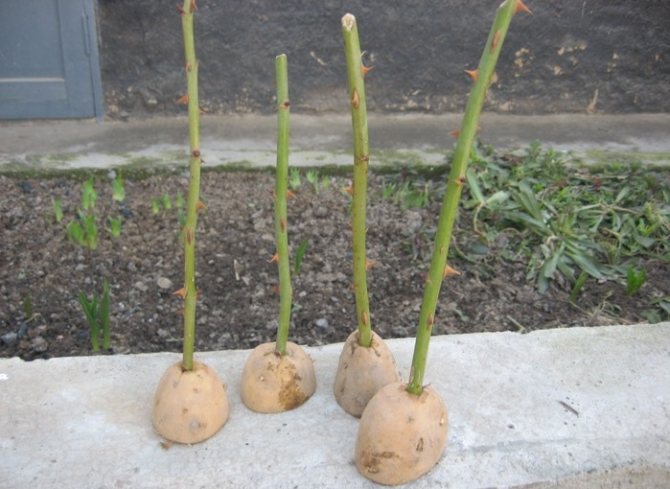

Rooting methods for cuttings


Rooting of cuttings depends on the variety of roses. If local varieties of roses are involved in the bouquet, then the shoots will give roots quickly and without problems. If a grower is going to grow roots on Dutch roses, then you can get a positive result on only 40% of the cuttings. This, it turns out, is due to the fact that roses are processed with certain hormones that slow down the process of wilting, but they also inhibit the formation of a root mass on the shoot.
Germination in water
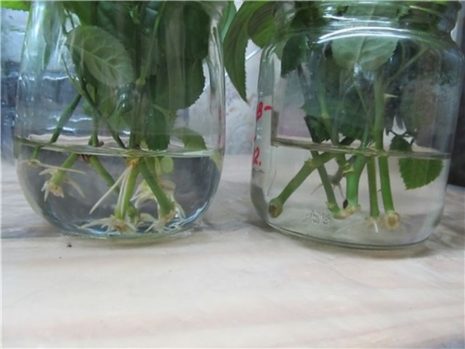

Germinating cuttings of roses in water is the easiest option. To do this, they are immersed in water by 1/3. Water must be used filtered and separated during the day. The vessel is placed in that place:
- where there are no drafts;
- there are no rays of the direct summer sun;
- no sudden changes in temperature.
It should be remembered that the water is changed every other day.After about a month, white tubercles will appear at the ends of the cuttings - these are future roots. When the roots become 5 cm long, the shoots are planted in nutritious and loose soil.
Using potatoes
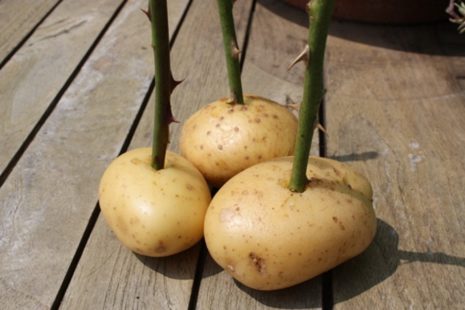

If you choose this method, the potatoes will serve as a breeding ground for the formation of roots. The potato tuber must be:
- healthy;
- no mechanical damage;
- strong and resilient.
To prepare the selected potatoes, it is necessary to remove all the eyes from it, rinse under running water and make holes with an awl, where the cutting will actually be inserted.
In this way, you can grow shoots in an apartment, or you can immediately in the open field. To do this, a shallow trench is dug, no deeper than 15 cm, a 5 cm layer of sand is poured and potato tubers with rose cuttings stuck into it are already placed on it. When burying the processes, the apical bud should be left on the surface.
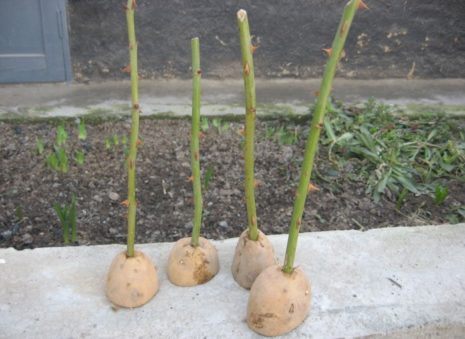

After planting, everything is spilled well with warm, settled water and covered with a cut plastic bottle to create a greenhouse microclimate. For the winter, such a shelter is not removed, but buried slightly with earth and then buried in snow. In the spring, a small bush will already be in place of the cutting. But such reproduction is suitable for the middle and southern regions of Russia; at the latitude of the Moscow region, young shoots must be additionally covered with spruce branches and lutrasil.
Using the package
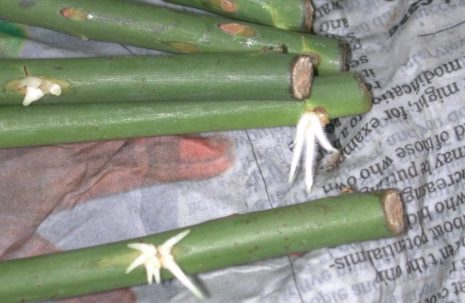

Today it is an unusual way to germinate the root system on a rose cut. All shoots are carefully wrapped in wet newspaper in such a way that cuttings do not peep out from under it. This wet bundle is placed in a black bag and put into a room where the air temperature will not rise above +20 degrees Celsius.


Rooting in a pot
This method is the most traditional. For this purpose you will need:
- Small capacity.
- Nutritious and loose soil.
- A glass jar large enough to cover a planted rose stalk.
- Shoots of roses.
The pot and expanded clay are poured over with boiling water to get rid of various fungal infections that may be there. The soil must be steamed in the oven for 20 minutes at 200 degrees - this is done to disinfect it from pests.
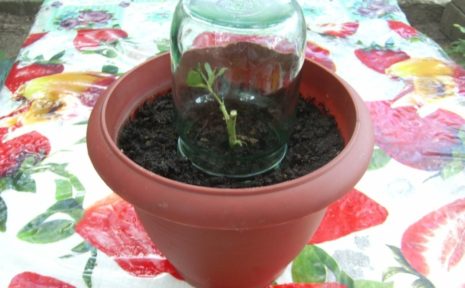

A 2 cm layer of expanded clay is placed in the prepared pot, the calcined soil is poured and well moistened. Now proceed directly to planting the prepared cutting. It is lowered with an oblique cut into the ground, deepening, so that the lower growth bud is submerged in the ground. The shoot is covered with a jar in order to form a humid greenhouse climate, this will give more guarantees for the viability of the cuttings.
If several cuttings of the same variety are planted in one container, then they are lowered into the ground with a step of 7 cm.
In the future, it is necessary to ensure that the soil under the jar or package does not dry out, but is moderately moist all the time. The temperature in the room where the cuttings will germinate should be in the range of 18-25 degrees Celsius. When small branches begin to grow from the internodes, there is no need to rush and immediately remove the jar. It is necessary to gradually accustom the young growth to the environment and the jar is raised by 2 cm so that air can enter under it. This will protect the cutting from black leg disease.
Features of growing roses
There are some subtleties of how to plant a sprout from it on the site. Remember that rose hips are very fond of warmth and hardly tolerate frosts, so it is worth preparing a special rose garden for your favorite flowers. So, here's what to remember about growing roses at home, in a greenhouse or on a plot:
- They are thermophilic and it is difficult for them to endure severe frosts;
- Regular sunlight is important - about 10 hours of daylight hours, so additional lighting of flowers will be necessary;
- Rose seedlings and cuttings must be carefully selected. Saplings can be both fresh and young, and woody.If a fresh rose has sprouted, then you can try to grow a new fragrant bush from it;
- Roses can be planted with other flowers. Tulips, peonies, forget-me-nots will not harm each other in the same garden. Among other things, they will look great with a home rosehip, although this flower looks great alone;
- It is important to prepare the soil for flowers in advance. This can be a ready-made rosary soil mixture or a mixture made with your own hands. Don't forget to add river sand to the mixture;
- Correct planting of cuttings. If the rose has sprouted, it should be properly prepared so that it does not die. The pruning of the stem, the season of planting, and the choice of cutting are important here;
- Regular Care Needed:
- Watering is regular but moderate. The soil should not hold excess moisture, but it is also harmful for it to dry out. As a rule, it will be enough to water the roses 2 times a week in the summer and once a week in the winter,
- Top dressing. Maintain sufficient soil nutrients for flowering and root development. Growth stimulants can be used periodically,
- Cover for the winter, especially if you managed to plant a climbing rose that spreads over the surface. This will protect the plant from death in the winter season,
- Shrub pruning is essential for the development of more beautiful and stronger shrubs. It is worth doing this with sharp tools, for example, a garden pruner,
- Help protect against pests. As a rule, these are spider mites, aphids and powdery mildew. It is advisable to use safe drugs for diseases and pests, which do not contain chemicals.
Landing in a permanent place
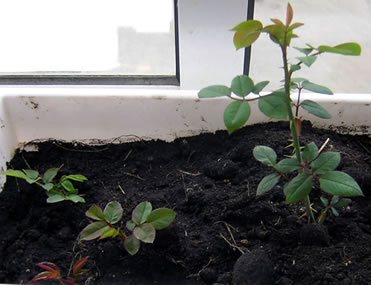

The optimal time for planting rooted cuttings is late spring. A gardener who knows how to grow a bush from a bouquet of roses will probably prefer a sunny, sheltered from the winds, not flooded area.
The dimensions of the dug holes must correspond to the size of the roots, organic matter is used to fertilize the soil. Before identifying seedlings in the ground for a permanent place of growth, they will need to trim the stems, leaving a maximum of 4 buds.
After the end of planting, the soil must be watered, mulched using peat, sawdust. Bushes should provide reliable shading. The start of the development of seedlings can be expected in 2 weeks. After the growing shoots reach a height of 12 - 15 cm, you will need to feed the bushes using complex fertilizers, infusion of mullein, herbs.
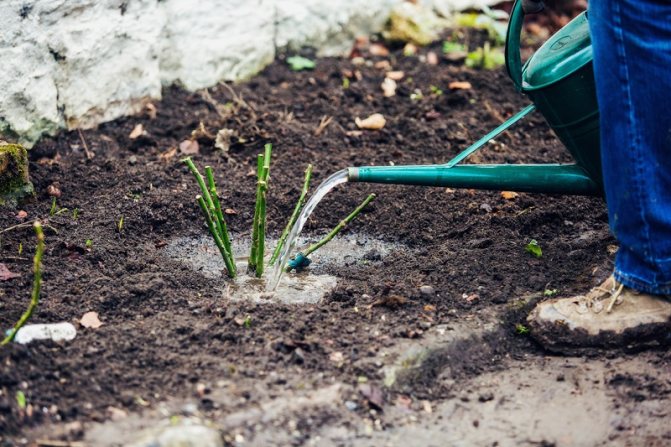

During the first year, young plants root thoroughly, which is why it is required to remove all buds that form from them. This will give them the opportunity to focus all their energy on growth. In anticipation of the onset of cold weather, roses should be provided with reliable shelter.
Prudent florists practice digging up especially valuable varieties, storing them until spring in a room with maintaining the desired humidity level, which prevents the roots from drying out.



